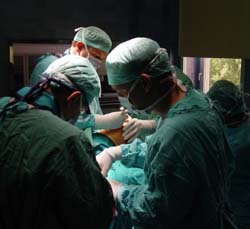and Other Way-Too-Common Surgical Mistakes

Surgical mistakes are more common than you think!
“Trust me, I’m a doctor!”
It’s frightening to think of the errors, mistakes, and “accidents” that happen because doctors insist on your unquestioning trust. Unfortunately, surgeons and their teams are all too human.
Take the case of a woman who had surgery at Nassau University in 2008. The operating team left behind a sponge the size of a cocktail napkin. Two days after surgery, the woman was vomiting and back at the hospital, wondering what was wrong. The medical resident did an X-ray, but the X-ray detectable stripe on the sponge was interpreted as tape on the outside of her body. It wasn’t until the case was bumped up to a senior doctor 48 hours later that the sponge was finally detected and removed.
In 2009, Nelson E. Bailey had surgery for diverticulitis at Good Samaritan Hospital in West Palm Beach. After surgery, he was supposed to get better, but he kept getting worse. It took five months before his doctors opened him back up and found the 12”x12” surgical sponge that had been left behind during the original surgery. Rotting away, it had created holes in his intestines and part of his gut had to be removed along with the sponge in order to save his life.
Of course, it’s not just sponges that are forgotten – there’s also cases like Donald Church, who had surgery to remove a tumor from his abdomen at Washington Medical Center in June 2000. During the procedure his surgical team used a 13-inch metal retractor to hold his organs in place during surgery… except they never took it out. Isolated incident? No, it was the fourth incident of a “left behind” at the hospital in as many years, and Mr. Church was fortunate to survive the experience.
How often are objects left inside after surgery?
The National Quality Forum reports that surgical instruments left behind during surgery are a “never event” since such things are never supposed to happen.
However, in 2009 in New York State alone, there were 84 reported cases of foreign objects left behind… barely an improvement over the 88 items reported left behind the previous year.
Altogether, in the United States some 1,500 people have objects left inside them after surgery every year… that we know about. That according to materials published by the Loyola University Health System.
The most commonly “forgotten” items are surgical sponges, which account for 2/3 of all objects left behind. When covered with blood, they can be mistaken for body tissue and abandoned. The problem has been such an ongoing issue that hospitals often have multiple systems in place to count, recount, and double check sponge locations before and after surgery. Loyola University scans bar codes on their sponges both on their way in and on their way out, while the American Journal of Surgery reports studies underway to use RF ID technology as a “foolproof” way to pin down sponge locations.
These methods help, but may not be enough. In the Nassau University case, the surgical team marked down that all sponges were accounted for even though they hadn’t actually checked.
Surgical mistakes — even more common than you think!
It’s not just things being left behind that you have to worry about either.
Serious surgical errors happen every day – between five and 10 daily in the United States according to The Journal of the American Medical Association – despite all the precautions in place.
Doctors perform surgery on the wrong patients, do the wrong procedures, and even amputate perfectly healthy limbs! Though they’d like you to think they can do no wrong, doctors, nurses, and medical assistants make serious mistakes every day of the week.
And Americans aren’t alone in their troubles. The World Health Organization Director-General Margaret Chan says errors in medical care affect one in 10 patients worldwide. These errors can be “minor” incidents such as accidentally cutting an adjacent organ during surgery, or they can be major issues, such as performing a bypass on the wrong artery or amputating a healthy limb.
Think it’s crazy something like that could even happen? So did Willie King, who had the wrong leg amputated at the University Community Hospital in Tampa in 1995. Benjamin Houghton had his non-cancerous testicle removed at the West Los Angeles VA Medical Center. Rhode Island Hospital drilled a hole in the wrong side of a patient’s head. And only a complaint from the doctor whose patient was supposed to be in the operation room stopped Joan Morris from getting the open heart surgery scheduled for another patient.
All in all, the number of people facing a medical error is 1 in 361 patients in the United States, according to the Institute of Medicine’s 1999 report, To Err is Human. The report points out that between 44,000 and 98,000 people die in hospitals each year as a direct result of medical errors that could have been prevented in 55% of cases.
To put things in perspective, more people die from medical mistakes in hospitals than die in car accidents every year.
The cost to hospitals is estimated between $17 billion and $29 billion, but who can put a price tag on the lives, health and well being of affected patients?
After a medical error, patients report feeling outraged, hurt, and paranoid about their future prospects for good medical care, even if they switch doctors. Despite ultimately receiving outstanding care for his heart from another doctor, actor/comedian Dana Carvey will never get over a double bypass on the wrong artery, “I was very lucky in that I didn’t sustain heart muscle damage. But knowing what I do now, I would never take a gamble like that again.”
4 Tips to Prevent Surgical Errors from Happening to You
How can you prevent surgical errors from happening to you, ruining your life, or even killing you? Hospitals are working on their own counting and checking systems, according to Becker’s Hospital Review, but you shouldn’t be passive when it comes to your health and your life. While there’s not 100% fool-proof method, here are four top tips:
- Avoid unnecessary surgery. Learn to live with your nose, go on a diet instead of having liposuction, and explore all-natural health cures first. After all, why risk your life on something like back surgery when there are so many ways to stop the pain now without surgery?
- Have a doctor you like and trust. Why work with a doctor you don’t know or don’t trust? Get a second opinion, transfer to a new doctor, or request someone else if you don’t have a relationship with your doctor that makes you feel comfortable about the surgery.
- Be an informed patient. Do your research. Is your doctor a student practitioner or fully licensed? How many of these procedures have they done? What exactly is supposed to happen in the operating room, and how should your recovery look? Does the surgical team do a count and check with every surgery? If you know what’s going on, what safety measures are in place, and what to look for in terms of problems, you’ll prevent and catch many errors before it’s too late.
- Know what’s special or different in your case — and make sure your doctor knows, too. Surgical errors and accidents happen more often when there is something complex or different about the surgery. Do extra preparation and research with your doctor going into a surgical situation if you know there is something different about your case.
 Considering Back Surgery?
Considering Back Surgery?
7 out of 10 Patients Who Tried THIS
No Longer Need Surgery!
References
Crowley, C. Mistakes, Advances in New York’s Hospitals. Times Union. 2010 Sep 20.
Falcon, M. Heart Operation No Laugh for Dana Carvey. USA Today. 2001 Nov 5.
Inbar, M. Doctors find 1-square foot sponge inside patient. MSNBC. 2010 Sep 15.
JAMA and Archives Journals. Surgical Errors Remain a Challenge in and out of the Operating Room. ScienceDaily. 2009 Nov 16.
Loyola University Health System. Surgical Objects Accidentally Left Inside About 1,500 Patients In US Each Year. ScienceDaily. 2007 Dec 8.
Oh, J. 4 Best Practices for Minimizing Retained Surgical Items. Becker’s Hospital Review. 2011 Feb 17.
Rosen Louik & Perry, P.C. 13 Disturbing Cases of Medical Malpractice. 2007.
Steelman, V. Sensitivity of detection of radiofrequency surgical sponges: a prospective, cross-over study. The American Journal of Surgery. 2010 Mar 31.
Institute of Medicine. To Err is Human: Building a Safer Health System. 1999 Nov.


Does adrenal fatigue have anything to do with breast cancer? If you already have a heart condition issue, and the medication your doctor wants to put you on for over a year Will further weaken your heart what should you do. Are there other avenues to shrink a tumor other than chemo and surgery.
There are lots of novel ideas, are any proven beyond a doubt, not sure, but the way we look at life and issues of the body, is that even if you have adrenal fatigue, that is only the symptom, the question you should be asking is, how did your adrenals get fatigued and what can you do to re-balance your life to have your body work in balance again…
There are lots of great ideas in this free new book: http://losethebackpain.com/endalldisease.php
Steve